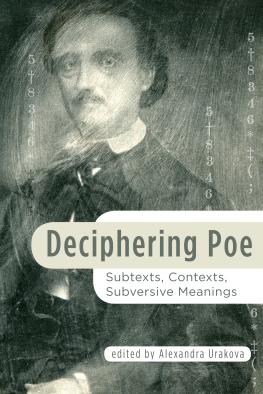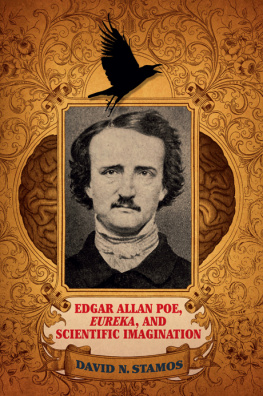Poe Edgar Allan - Deciphering Poe: subtexts, contexts, subversive meanings
Here you can read online Poe Edgar Allan - Deciphering Poe: subtexts, contexts, subversive meanings full text of the book (entire story) in english for free. Download pdf and epub, get meaning, cover and reviews about this ebook. City: Bethlehem, year: 2015;2012, publisher: Lehigh University Press, genre: Detective and thriller. Description of the work, (preface) as well as reviews are available. Best literature library LitArk.com created for fans of good reading and offers a wide selection of genres:
Romance novel
Science fiction
Adventure
Detective
Science
History
Home and family
Prose
Art
Politics
Computer
Non-fiction
Religion
Business
Children
Humor
Choose a favorite category and find really read worthwhile books. Enjoy immersion in the world of imagination, feel the emotions of the characters or learn something new for yourself, make an fascinating discovery.
- Book:Deciphering Poe: subtexts, contexts, subversive meanings
- Author:
- Publisher:Lehigh University Press
- Genre:
- Year:2015;2012
- City:Bethlehem
- Rating:5 / 5
- Favourites:Add to favourites
- Your mark:
- 100
- 1
- 2
- 3
- 4
- 5
Deciphering Poe: subtexts, contexts, subversive meanings: summary, description and annotation
We offer to read an annotation, description, summary or preface (depends on what the author of the book "Deciphering Poe: subtexts, contexts, subversive meanings" wrote himself). If you haven't found the necessary information about the book — write in the comments, we will try to find it.
Deciphering Poe: subtexts, contexts, subversive meanings — read online for free the complete book (whole text) full work
Below is the text of the book, divided by pages. System saving the place of the last page read, allows you to conveniently read the book "Deciphering Poe: subtexts, contexts, subversive meanings" online for free, without having to search again every time where you left off. Put a bookmark, and you can go to the page where you finished reading at any time.
Font size:
Interval:
Bookmark:
Deciphering Poe
Perspectives on Edgar Allan Poe
Series Editor: Barbara Cantalupo
Embracing interdisciplinary perspectives, cultural studies, and traditional scholarship, Perspectives on Edgar Allan Poe publishes scholarly interpretations of Edgar Allan Poes works, influences, and contexts to enhance Poe studies within and beyond the parameters of nineteenth-century American literary history.
Titles in the Series
Deciphering Poe: Subtexts, Contexts, Subversive Meanings edited by Alexandra Urakova
Poes Pervasive Influence edited by Barbara Cantalupo
Deciphering Poe
Subtexts, Contexts, Subversive Meanings
Alexandra Urakova
LEHIGH UNIVERSITY PRESS
Bethlehem
Published by Lehigh University Press
Co-published with The Rowman & Littlefield Publishing Group, Inc.
4501 Forbes Boulevard, Suite 200, Lanham, Maryland 20706
www.rowman.com
10 Thornbury Road, Plymouth PL6 7PP, United Kingdom
Copyright 2013 by Rowman & Littlefield Publishers, Inc.
All rights reserved. No part of this book may be reproduced in any form or by any electronic or mechanical means, including information storage and retrieval systems, without written permission from the publisher, except by a reviewer who may quote passages in a review.
British Library Cataloguing in Publication Information Available
Library of Congress Cataloging-in-Publication Data
Deciphering Poe : subtexts, contexts, subversive meanings / edited by Alexandra Urakova.
pages cm
Includes index.
ISBN 978-1-61146-139-8 (cloth : alk. paper) -- ISBN 978-1-61146-140-4 (electronic)
1. Poe, Edgar Allan, 1809-1849--Criticism and interpretation. I. Urakova, A. P., editor of compilation.
PS2638.D396 2013
818'.309--dc23
2013019612
 TM The paper used in this publication meets the minimum requirements of American National Standard for Information Sciences Permanence of Paper for Printed Library Materials, ANSI/NISO Z39.48-1992.
TM The paper used in this publication meets the minimum requirements of American National Standard for Information Sciences Permanence of Paper for Printed Library Materials, ANSI/NISO Z39.48-1992.
Printed in the United States of America
I took the editorship of this collection after Barbara Cantalupo had already done the preliminary work of selecting and reviewing the papers. Since that time, her help has been essential to the volume, and I am indebted to her generosity and willingness to give me a hand in the process of preparing the manuscript.
The director of the Poe Museum in Richmond, Harry Lee Poe, supported me from the very beginning; I am particularly grateful to him for helping us obtain permissions for some of the illustrations included in the volume.
The Poe Studies Association was very generous in supporting this project financially, and I would like to thank personally the PSA Executive Committee and the PSA current president, John Gruesser, for their generous gesture.
Alexandra Urakova
After the two-hundredth anniversary of his birth, The aim of this volume, then, is twofold: to expand the contextual framework of Poes work and to interpret still unrevealed subtexts of his poetry, prose, and social behavior that provide a more attenuated vision of Poes place and role in nineteenth-century American literature. Contributors to this volume searched for the hidden clues that allowed them to reconsider Poes literary and intellectual debts, ones that heretofore have escaped critical attention. The authors demonstrate how obscure texts or side elements of Poes art/discourse influence his exemplary, well-known literary techniques. They examine the parodic, ironic, and hoaxing character of his work, as well as the ways his sophisticated narrative strategies subvert the ideological clichs and stereotypes of his time. Thus, the question of how we should read Poe today remains as essential as ever.
The eleven chapters in this volume vary in their approaches. Rereadings of works like The Narrative of Author Gordon Pym, The Raven, and The Fall of the House of Usher alternate with chapters discussing lesser-studied pieces like Tamerlane and Catholic Hymn. Analyses of Poes short fiction in light of its philosophical background and antebellum social constructions of race and gender are supplemented by investigations in biography and reception. What unites the chapters is their attention to the subversive nature of Poes art found in the subtle, minute details of his life and work, whether that might be the pseudonym used in the first printing of The Raven or the history of the Odeon stage where Poe infamously delivered Al Aaraaf in 1845. Close reading techniques have a direct counterpart in Poes tales when we think of Dupins or Legrands meticulous attention to the apparently insignificant material details and facts. Jorge Luis Borges claimed that Poe invented the reader of detective tales; it would not be an exaggeration to say that Poe also invented his future critics, who largely borrow his own methods to decipher his life and work.
Author of the Dupin tales, The Gold-Bug, and A Few Words on Secret Writing, Poe possessed what Shawn Rosenheim called the cryptographic imagination, referring not only to stories that explicitly include ciphers or codes but to a constellation of literary techniques concerning secrecy in writing. Reexamining his heritage in its complex interrelation with contemporary notions of race, sexuality, and gender, scholars bring to light subjects and issues that are central to his work but by no means obvious; rather, like the purloined letter, they are exposed and concealed at the same time.
Most of the chapters here offer a textual analysis of Poes poetry and fiction. The first four chapters form a poetical block. It is not surprising that poetry evokes a discussion of biographical allusions and subtexts, such as Poes complex relations with John Allan or the irrecoverable loss of his mother, Elizabeth Arnold. Poes poems, from Tamerlane to The Raven, are placed at the junction of biographical, social, and literary contexts; much attention is paid to genetic relations of the early poetical experiments to mature work. From Poes poetry we move through an account of the actual poetic performance in Boston to the analysis of his prose in the six chapters that follow. Deciphering Poe encompasses Poes detective stories as well (The Purloined Letter, The Mystery of Marie Rogt), and texts explicitly using codes and secret writing (The Gold-Bug, The Narrative of Arthur Gordon Pym). This block falls into two parts thematically organized around the intellectual subtexts of Poes fiction, on the one hand, and its social (mainly racial) implications, on the other. Chapters 5 to 7 predominantly consider the question of sublimity in Poe, showing the authors critical and ambiguous attitude to the existing philosophical tradition. Poes intellectual thought is seen as subversive to the existing philosophical tradition and at the same time as anticipating the theoretical and critical thinking of the twentieth century. Precursor of both the twentieth centurys intellectual and mass culture (the latter thesis is developed in chapter 8), Poe at the same time shared many prejudices of his contemporaries, notoriously including those about race. However, the chapters in Deciphering Poe reconstruct Poes radical artistic gesture that placed his work in opposition not only to explicit racist ideology as such but also to the average racism nourishing the popular imagination. The last chapter expands the volumes framework by exploring the role that Poes daguerreotypes played in his reception at the turn of the nineteenth and twentieth centuries. The history of Poes reception in the United States is notorious for being largely the history of his misrecognition. While much has already been written about the ambiguities of Poes afterlife at home, this study offers a different approach to the subject, showing how attempts to reevaluate Poe as a national genius were themselves not free from stereotypical thinking about gentility and race.
Font size:
Interval:
Bookmark:
Similar books «Deciphering Poe: subtexts, contexts, subversive meanings»
Look at similar books to Deciphering Poe: subtexts, contexts, subversive meanings. We have selected literature similar in name and meaning in the hope of providing readers with more options to find new, interesting, not yet read works.
Discussion, reviews of the book Deciphering Poe: subtexts, contexts, subversive meanings and just readers' own opinions. Leave your comments, write what you think about the work, its meaning or the main characters. Specify what exactly you liked and what you didn't like, and why you think so.








